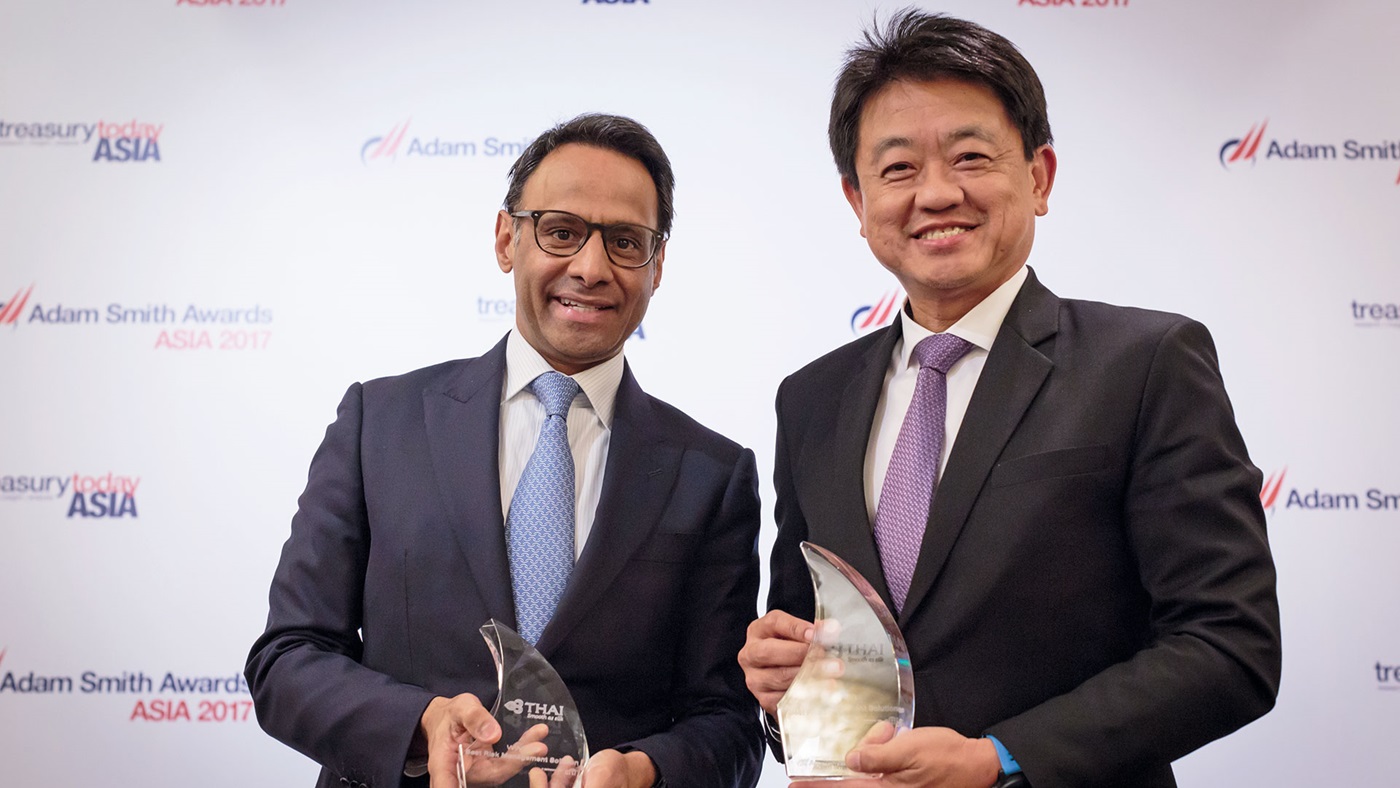
Photo of Munir Nanji, Citi and Narongchai Wongthanavimok, Thai Airways International.
The solution here addresses two key risks to which THAI Airways was exposed; transaction FX Risk from operating flows and translation FX risk from the balance sheet. These risks are especially heightened during volatile markets. The key concept of the solution is for THAI Airways to use its own net cash surplus in some currencies to service foreign currency debt to reduce FX translation risk, simultaneously, with lower funding cost and to align with its hedge accounting treatment.
Narongchai Wongthanavimok
Chief Finance Officer

Thai Airways International (THAI) is the national flag carrier airline of Thailand, based at Bangkok’s Suvarnabhumi Airport, providing air transportation, freight and mail services on domestic and international routes including Asia, Europe, Middle East, Australia and New Zealand. THAI is one of the founding members of Star Alliance.
in partnership with

Solution to FX translation and transaction risk
The challenge
One of THAI Airways’ most complex issues is due to the challenges related to foreign exchange (FX) movement, especially during a volatile market, as THAI is exposed as follows:
Transaction FX risk (from operating flows)
- Foreign currency income from selling tickets in different currencies: THAI generates revenue in more than 50 currencies around the world (38% in THB, 35% in five major currencies – USD, EUR, JPY, RMB and AUD, and the rest in other currencies, as of year-end 2016).
- Foreign currency expenses from operating in different currencies: the most significant foreign currency exposure is from jet fuel purchases which are in USD – accounting for around 50% of total expense – hence, causing a big mismatch between income and expense.
Translation FX risk (from the balance sheet)
- Foreign currency debt: especially USD while THAI doesn’t have enough USD inflow to cover USD debt. In addition, for aircraft financing, most lenders are offshore institutions. Therefore, borrowings are normally transacted in foreign currencies.
- Foreign currency asset: aircraft assets are denominated in THB on the balance sheet for statutory reporting. However, aircrafts are transacted from initial acquisition to operations to disposal solely in USD and in such a long tenor (over 15 to 20 years). This creates a huge mismatched and long-dated USD/THB risk.
THAI was faced with material impact on its P&L from FX movement. Hence, the airline has had concentration on FX risk management with the aim of reducing the impact from FX volatility.
Narongchai Wongthanavimok, Chief Financial Officer explains, “We were looking for a holistic solution to decrease our exposure to both transaction and translation FX risks by aligning our foreign currency inflows with our outflows, thereby reducing income statement volatility.”
The solution
THAI has implemented a “Balance Sheet Risk Management” solution to address FX translation risk. The key concept of the solution is to use its own net cash surplus in some currencies to service foreign currency debt and/or restructure existing mismatched foreign currency debt to match net cash surplus to reduce FX translation risk simultaneously, with lower funding cost and to align with its hedge accounting treatment. Citi’s global FX solution for THAI is holistic, practical and accounting-friendly. The solution involves the revenue flow in more than 50 countries against foreign currency debt in USD, EUR and JPY.
THAI started implementing the FX risk management solution in 2016 and has successfully hedged its USD loan exposure as of the year-end 2016. The hedge mechanism is based on the fact that THAI is always short in USD since the fuel cost (a major expense) is denominated in USD. THAI concluded that it should not have USD underlying loan in the balance sheet as there is no sufficient USD cash flow to service the debt obligation. After the trade execution, the USD loan profile is converted to CHF which is perfectly matched with the excess cash from CHF revenue flow. In addition to the success of USD exposure management, THAI has also benefitted from cost savings for converting USD to CHF at approximately 250bps interest rate saving.
Best practice and innovation
The solution is innovative, comprehensive, practical and unique, combining several hedge instruments to minimise the overall FX translation risk to an acceptable risk tolerance and to simultaneously lower funding costs.
The solution enables flexibility for THAI via a dynamic risk management strategy, should THAI’s cash flow profile change at any time in the future and enables THAI to easily execute and monitor its own FX portfolio.
Key benefits
- Reduced FX translation risk to an acceptable level with reasonable hedging costs.
- Standardised THAI’s FX risk management framework.
- Recognised interest cost savings from the hedge instruments recommended.
- More balanced currency mix of THAI’s FX portfolio.
- Increased operational efficiency with competitive FX pricing.
- Increased control and visibility, as FX risk management is now centralised in Thailand.